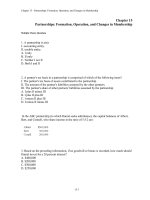Kendall7E ch15
Bạn đang xem bản rút gọn của tài liệu. Xem và tải ngay bản đầy đủ của tài liệu tại đây (967.27 KB, 65 trang )
Designing Accurate
Data Entry Procedures
Systems Analysis and Design, 7e
Kendall & Kendall
© 2008 Pearson Prentice Hall
15
Learning Objectives
• Understand the uses of effective coding to
•
•
•
support users in accomplishing their tasks
Design effective and efficient data capture
approaches for people and systems
Recognize how to ensure data quality
through validation
Articulate accuracy advantages of user
input on ecommerce Web sites
Kendall & Kendall
15-2
Accurate Data-Entry Objectives
• Effective coding
• Efficient data capture
• Effective data capture
• Assuring data quality through validation
Kendall & Kendall
15-3
Major Topics
• Effective coding
• Types of codes
• Guidelines for coding
• Validation methods
• Check digits
• Ecommerce accuracy
Kendall & Kendall
15-4
Effective Coding
• Data that are coded require less time to
enter
• Coding helps to reduce the number of
items entered
• Coding can help in sorting of data
during the data transformation process
• Coded data can save valuable memory
and storage space
Kendall & Kendall
15-5
Human Purposes for Coding
• Keeps track of something
• Classifies information
• Conceals information
• Reveals information
• Requests appropriate action
Kendall & Kendall
15-6
Keeping Track of Something
• Simple sequence code
• Alphabetic derivation codes
Kendall & Kendall
15-7
Simple Sequence Codes
• A number that is assigned to something
if it needs to be numbered
• No relation to the data itself
Figure 15.1 Using a simple sequence code
to indicate the sequence in which orders
enter a custom furniture shop
Kendall & Kendall
15-8
Simple Sequence Codes
(Advantages)
• Eliminates the possibility of assigning
the same number
• It gives users an approximation of when
the order was received
Kendall & Kendall
15-9
Simple Sequence Codes
(Disadvantages)
• When you do not wish to have someone
read the code to figure out how many
numbers have been assigned
• When a more complex code is desirable
to avoid a costly mistake
Kendall & Kendall
15-10
Alphabetic Derivation Codes
• A commonly used approach in
identifying an account number
Figure 15.2 Identifying the account of a magazine
subscriber with an alphabetic derivation code
Kendall & Kendall
15-11
Alphabetic Derivation Codes
(Disadvantages)
• When the alphabetic portion is small or
when the name contains fewer
consonants than the code requires
• Names like ROE - become RXX
• Some of the data may change
Kendall & Kendall
15-12
Classification Information
• Affords the ability to distinguish
between classes of items
• Must be mutually exclusive
• Classification codes
• Block sequence codes
Kendall & Kendall
15-13
Classification Codes
• Used to distinguish one group of data
with special characteristics from another
• Can consist of either a single letter or a
number
• A shorthand way of describing a person,
place, thing, or event
• Listed in manuals or posted so that
users can locate them easily
Kendall & Kendall
15-14
Classification Codes
• Use a single letter for a code
Figure 15.3 Grouping tax-deductible items
through the use of a one-letter classification
code
Kendall & Kendall
15-15
Block Sequence Codes
• An extension of the sequence code
• Data are grouped according to common
characteristics
• Simplicity of assigning the next
available number (within the block) to
the next item needing identification
Kendall & Kendall
15-16
Figure 15.5 Using a block sequence code
to group similar software packages
Kendall & Kendall
15-17
Concealing Information
• Codes may be used to conceal or
disguise information
• Cipher Codes
Kendall & Kendall
15-18
Cipher Codes
• The direct substitution of one letter for
another, one number for another, or
one letter for a number
Kendall & Kendall
15-19
Figure 15.6 Encoding markdown prices with a cipher
code is a way of concealing price information from
customers
Kendall & Kendall
15-20









